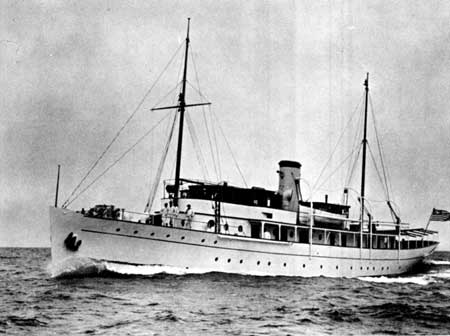|
VANDERBILT MANSION National Historic Site |
 |

Vedette II, Vanderbilt's last yacht.
A Way of Life
In the 1890's approximately nine-tenths of the wealth of the country was controlled by one-tenth of the population. It was an era of triumphant business enterprise when men of ambition and talent concentrated their energies on gathering the abundant fruits of America's burgeoning industrial might. It was a time when the income tax had been ruled unconstitutional; a time when the captains of industry and commerce could use their millions for pursuits and pastimes that made even the wonders of Aladdin pale.
The great mansion was typical of these amazing enterprises. And typically, the owners ransacked Europe for art treasures and furnishings with which to fill them. The Vanderbilt family alone built four of these "baronial halls." Frederick Vanderbilt's Hyde Park mansion was matched in elegance by those of his three brothers: George Washington Vanderbilt's Biltmore, near Asheville, N.C., was reputed to have cost $3 million; Cornelius Vanderbilt II built the elaborately decorated Breakers at Newport, R.I.; William K. Vanderbilt's Spanish-Moorish mansion, Eagle's Nest, is at Centerport, Long Island. Today, all are open to the public—museums of art, memorials to an age.
A favorite pastime of wealthy sportsmen was yachting—and in the Vanderbilt family, this was almost as fixed a tradition as railroading. From 1889 to 1938, Frederick Vanderbilt kept that tradition alive with a series of four large seagoing luxury craft. During World War I, he donated the third of these, Vedette I, to the United States Government, and it was used by the Navy for submarine patrol in the Atlantic. The fourth ship, Vedette II, was built at Copenhagen in 1924. This twin-screw diesel craft—158 feet long with a 23-man crew—was used by Vanderbilt until his death.
Aside from yacht owning, there were the international yacht races for such prizes as the America's Cup. Several times Vanderbilt joined with other sportsmen in financing entries to these races. In 1934, one of these entries, the Rainbow, won the cup at Newport.
The pattern of life followed by the Vanderbilt's was typical, not only of their own Hyde Park neighbors, but of others of their station. A more or less uniform cycle was followed year after year.

The Frederick Vanderbilt townhouse at Fifth Avenue and 40th
Street, New York City, razed in 1914.
Courtesy Underhill Studio,
New York.
New York City was then the hub of the financial and business world, and here were centered the formal social interests of the wealthy. Consequently, it was essential that a townhouse be maintained there, though not necessarily as a principal residence. Depending upon their other interests, the members of this select group often moved about with the seasons.
About the middle of November, the Vanderbilts would go to New York for the opera and social season, staying at their town house until the end of January. On weekends in this period and at Christmas, they usually returned to Hyde Park, staying in the pavilion after the mansion was closed up about December 1.

|

|

| History | Links to the Past | National Park Service | Search | Contact |
|
Last Modified: Mon, Mar 4 2002 10:00:00 pm PDT |

